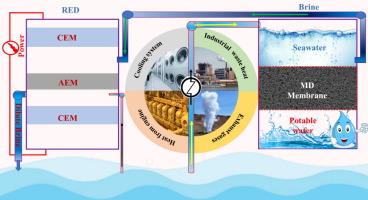膜蒸馏-反电渗析协同优化可持续脱盐及盐度梯度发电
IF 9
1区 工程技术
Q1 ENGINEERING, CHEMICAL
引用次数: 0
摘要
以海水反渗透为主导的海水淡化存在诸如水回收率低(~ 50% %)、盐水管理挑战和高能耗等问题。本研究提出了一种膜蒸馏(MD)和反电渗析(RED)相结合的优化策略,以降低膜蒸馏盐水的能源需求和环境足迹。在MD和RED上进行的大量实验室规模的实验表明,饲料浓度、温度和流动条件的新型参数优化可以最大限度地提高水的回收率和能量输出。MD设计实现了每平方米每小时(LMH) 27 L的最大通量,提高了80% %的水回收率。在60 °C和5 M MD盐水浓度下,RED堆叠的开路电压为0.55 V,最大功率密度为0.47 W/m2。该研究强调了通过MD和RED的整合实现的过程强化,其中脱盐和能量回收之间的协同作用显着提高了系统效率。此外,具体的热能消耗计算表明,使用低品位废热与过程强化具有协同作用,并符合循环经济范式。本文章由计算机程序翻译,如有差异,请以英文原文为准。

Synergistic optimization of membrane distillation-reverse electrodialysis for sustainable desalination and salinity gradient power generation
Water desalination, dominated by seawater reverse osmosis, presents issues such as low water recovery (∼50 %), brine management challenges, and high energy consumption. In this study, an optimized strategy integrating membrane distillation (MD) and reverse electrodialysis (RED) is proposed to reduce the energy demands and environmental footprint of MD brine. Extensive lab-scale experiments on MD and RED demonstrated a novel parametric optimization of feed concentrations, temperatures, and flow conditions to maximize water recovery and energy output. The MD design achieved a maximum flux of 27 L per square meter per hour (LMH), enhancing water recovery by up to 80 %. The RED stack reached an open circuit voltage of 0.55 V and a maximum power density of 0.47 W/m2 at 60 °C and 5 M MD brine concentration. The study emphasizes the process intensification achieved through the integration of MD and RED, where synergistic interactions between desalination and energy recovery significantly enhance system efficiency. Moreover, specific thermal energy consumption calculations indicate that using low-grade waste heat is synergistic with process intensification and aligns with the circular economy paradigm.
求助全文
通过发布文献求助,成功后即可免费获取论文全文。
去求助
来源期刊

Separation and Purification Technology
工程技术-工程:化工
CiteScore
14.00
自引率
12.80%
发文量
2347
审稿时长
43 days
期刊介绍:
Separation and Purification Technology is a premier journal committed to sharing innovative methods for separation and purification in chemical and environmental engineering, encompassing both homogeneous solutions and heterogeneous mixtures. Our scope includes the separation and/or purification of liquids, vapors, and gases, as well as carbon capture and separation techniques. However, it's important to note that methods solely intended for analytical purposes are not within the scope of the journal. Additionally, disciplines such as soil science, polymer science, and metallurgy fall outside the purview of Separation and Purification Technology. Join us in advancing the field of separation and purification methods for sustainable solutions in chemical and environmental engineering.
 求助内容:
求助内容: 应助结果提醒方式:
应助结果提醒方式:


